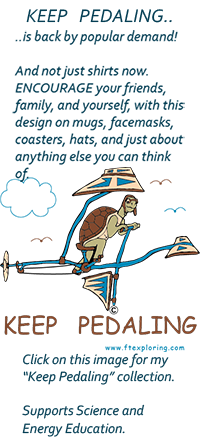 |
| |
 |
|
| |
It's not an ancient Egyptian device to channel mystical energy into the mummies
of Pharohs (we strongly discourage such silly ideas).
It's just another way (see previous
food chain stuff) to help visualize where and how
energy moves through living organisms (plants, animals, bacteria, fungus,
etc).
Look at the drawing below (another one of our much
loved colored pencil drawings). You've probably noticed that it is more of a triangle
than a pyramid. You will have to imagine the other 3 sides of a spacious 3 dimensional
pyramid because we can barely draw a triangle.
|
|
 |
 |
 |
|
|
| |
| |
The
Tiny Little Critters that Weigh More than the Big Guys:
As
we said in previous pages, energy on land moves from plant
to animal to animal in bite sized chunks. For almost all animals, the energy that
allows them to "keep on going" comes from the sun. But animals can't
get energy directly from the sun (except sometimes for warmth). They need help.
In the ocean, that help comes from a whole bunch of little tiny greenish critters
(organisms might be the word more sophisticated sources would use) called phytoplankton
(or photoplankton?).
Phytoplankton do for ocean animals what the
green plants on land do for the land animals. They make themselves into food for
everyone else.
Isn't that thoughtful?
Yup, they are the ones (pretty much the only ones
in the ocean) that turn sunlight and carbon and oxygen into glucose and other
simple sugars (by a process called photosynthesis)
and other molecules that animals can eat. From this tiny but very numerous beginning
the sun's energy begins its progression up through the food
chain.
But as the energy moves up the food chain from phytoplankton
to animal to animal there is less and less of it available for animals to use
(see the previous section on Energy Flow through Plants and
Animals).
Because there is less and less energy to go around
as it moves through the animal food chain, there are less and less animals; and
even though some of the animals get pretty big, the total mass and weight of those
animals is much less than the total mass and weight of the Primary Producers.
The little Primary Producers in the oceans have to keep busy - not just busy making
carbohydrates from sunlight, but also busy reproducing themselves. The typical
life span of one of these little phytoplankton critters is just 1 to 5 days. So
we need them to stay focussed, stay numerous, and keep busy, busy, busy. All other
living things depend on them.
|
|
 |
 |
 |
| |
 |
|
| |
It
was good to be a big shark on top of the food pyramid, but Bob never forgot his
debt to the photoplankton. |
|
 |
 |
 |
|
|
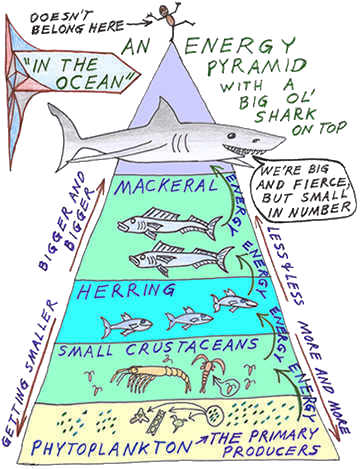
| Another
term that is often used instead of phytoplankton is photoplankton.
This is because the bacteria and algae that float in oceans and lakes and do photosynthesis
are no longer considered to be plants by most scientists. Phyto means plant. Photo
just refers to light and so is more general and can be used to describe any plankton
that is able to do photosynthesis. But since people use both words we will use
both words too. This will either totally confuse you or make you smarter and less
uptight about nomenclature. See Dr. G's beautiful answer about whale
and dolphin names to get some fascinating know-it-all information on naming
things. |
The
above drawing is just one example of the countless pyramids that can be drawn.
You might put a sperm whale on top,
and some different sizes of squid in between. On land you might put lions, and
tigers, and bears (oh my!) on the top, green plants on the bottom, and various
insects and herbivores in between. Or you could add some seals above the fish
because seals mostly eat fish, and then you could put a polar bear on top of the
seals because polar bears mostly eat seals. I'll bet if you thought about it,
you could come up with some energy pyramids of your own.
But remember that most ecosystems are very complicated
and an energy pyramid is just to sort of show the basic idea. There is no way
we could really show all the possible ways that animals eat each other and all
the possible ways that energy moves through the food chain.
The main point is to show that there is less and
less energy available as it moves up the food chain.
That's why the pyramid is big on the bottom and
small on the top. There is a lot more energy available to animals on the bottom
than on the top.
But maybe we shouldn't call the widest part of the
pyramid the bottom. Maybe we should call it the "Start". It is the place
where energy starts its journey through the food chain.
|
|
|
| |
| |
|
|
| |
They
are called the great meadow of the sea. Billions and billions of very small living
cells floating near the surface of the ocean where they use sunlight to make molecules
of stored energy and building material for themselves and for animals to use.
These cells are mostly algae and blue-green algae (the blue-green algae are often
called cyanobacteria nowadays - new name, same critters).
Digression
on Nomenclature:
Back when I was in school
we called these little guys phytoplankton, and a lot of people still do
(like me in this article). But there are also some folks calling them photoplankton
(put an "o" where the "y" used to be). We have to admit
this makes more sense, because phyto means plant in ancient Greek, and the algae
and cyanobacteria that make up the "great meadow of the sea" are not
classified as plants in the newer classification systems. On the other hand, who
remembers ancient Greek? |
There are two types of plankton - photoplankton
and zooplankton. The "photo" or "phyto" guys you just learned
about. The "zoo" guys are the animals. They eat the photo guys or each
other. Sound familiar? The photo guys are the primary producers
in the ocean world.They turn the sun's energy beams into something useful for
the rest of us. Everybody else thanks them by eating them, or eating the ones
that eat them, or by eating each other. There's a whole lot of eatin' going on,
and on, and on, and on! (appologies to Jerry Lee Lewis)
We humans do our share of eating too. But maybe
we should remind ourselves not to take our food sources for granted. We need them
(they don't need us).
Zooplankton
Zooplankton are little animals that live amongst,
and eat, the phytoplankton. They are mostly made up of little crustaceans like
shrimp, and little squids, and maybe some really little fish, and some babies
of marine critters that will eventually get much bigger. Then bigger animals eat
them and bigger animals eat them, etc., etc., etc. Have you noticed there are
lots of etc's in food chains and energy pyramids? There are "jillions"
of possible combinations of who is eating whom. (Is that the correct grammer,
Teach?)
One of the most common zooplankton animals are small
shrimp-like crustaceans called krill. Krill especially like to eat a phytoplankton
called diatoms, a common type of algae. A lot of these organisms live in the Antarctic
Ocean. One source we found estimates that 1.3 billion tons of krill are produced
in the Antarctic Ocean every year. That is a lot of krill.
The krill and other zooplankton provide food for
animals like seals, squid, fish, penguins, and the earth's largest carnivores,
baleen whales.
. |
|
 |
 |
 |
|
|
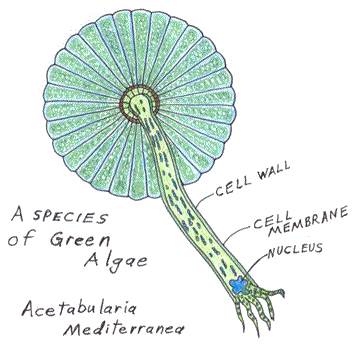
| The
drawings above and below are just a few examples of the many forms of phytoplankton
(or photoplankton). Top of Page. |
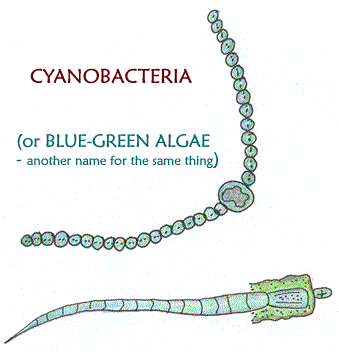
The organism
formerly known as Blue-Green Algae.
| |
Here we have a picture of a squid and a feather.
What does it mean? We haven't the foggiest idea.
Maybe it is just a way to show there are all sizes of squids and some of the smallest
squids make up some of the zooplankton that eat the phytoplankton. |
|
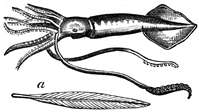 |
 |
 |
 |
 |
|
|
| |
|
|
|
|
| |
| |
|
|
| |
Consider
the mighty whale. Most of the really big whales don't even have teeth. They have
"curtains" of something called baleen hanging from their upper jaw.
They use this baleen like a sieve or a net to catch their food. And what do these
mighty beasts, the largest animals that have ever lived, eat? Well, the ones with
baleen eat plankton and very very small fish. You probably knew that.
So here comes a simplified version of the energy
path for baleen whales:
First the sun's energy rays (electromagnetic radiation
to be fancy about it) go shooting into the ocean. Some of those rays of energy
hit the billions of photoplankton (or phytoplankton) organisms that are floating
there.
Those fantastically clever phytoplankton (or photoplankton)
turn that sun's energy into molecules of themselves. One of the most common of
these photoplanktons are called diatoms.
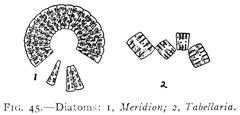
Untold billions of diatoms (and other photoplanton)
are eaten by untold billions of shrimp (and other zooplankton).

Then, guess what? Gigantic big whales, bigger than
anything that has ever lived, come along like big ol' suction machines, and gobble
up untold millions of little shrimp, fish, and other zooplankton, just as calmly
as you please. Not exacly T-rex, eh?
So they skip a few levels of the energy pyramid.
Nothing wrong with that. In fact, it seems pretty clever and very efficient to
us. That is why there is plenty of energy for those really big guys in that vast
ocean. It hasn't been used up by several layers of bigger and bigger fish eating
each other and using up more and more of the sun's precious energy.
They are carnivores because they eat other animals,
but they're also a lot like herbivores because they "graze" rather than
using a lot of energy rushing around fighting and biting and tearing and killing
other animals.
. |
|
| |
|
|
| |
|
|
 |
 |
 |
|
|
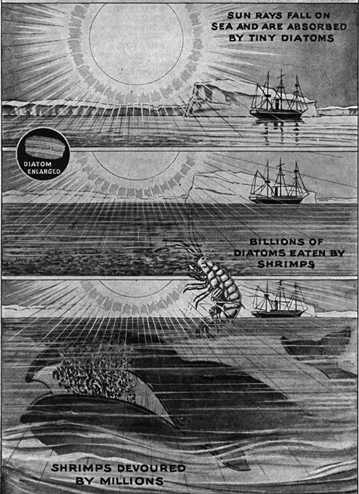
The
Placid Cruisers
The baleen whales calmly cruise around gulping tons
and tons of plankton into their several stomachs all day long. They are technically
carnivores since they eat other animals. But placidly "grazing" around
all day like cows makes them seem more like herbivores. And they get their energy
close to the "bottom" of the energy pyramid. What might an energy pyramid
for baleen whales look like? |
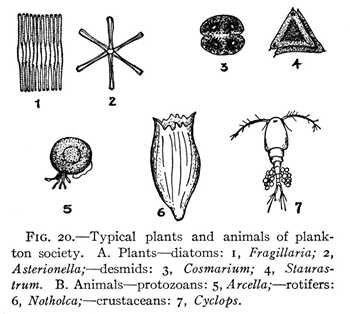
Oops, the
taxonomy for the pictures above is a little outdated.
|
|
| |
|
|
|
|
| |
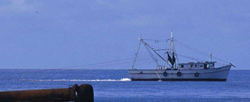
|
|
Then
along came some land living folks that wanted to get some of that phytoplankton
solar energy all the marine animals were enjoying. They were omnivores which means
they could eat both plants and animals. They were engineers,
which means they were always thinking of ways to enable a small number of people
to catch or make more food than they could use, so that the rest of the people
didn't have to. |
|
| |
So
they made boats with big diesel engines and went to sea. They dragged long nets
through the water and caught lots of shrimp. Way more shrimp than the small crew
of the boat could eat.
The ship's storage spaces were full of the little
former eaters of plankton and zooplankton. They caught them by the untold billions,
just like the baleen whales. Most of the shrimp they caught were bigger than the
tiny ones the whales caught. |
|
|
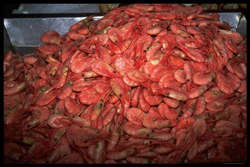 |
|
| |
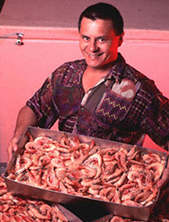 |
|
Then the busy engineer omnivores took their shrimp
catching boats back to land. The shrimp were quickly unloaded.
Next the shrimp were put into jet airplanes and speedy
trucks (which were powered with a liquid form of stored solar energy called jet
fuel and diesel fuel). The speedy trucks and airplanes took the shrimp all over
the world to people that lived far from the ocean but still wanted to power themselves
with phytoplankton solar energy that the zooplankton, and the animals that ate
the zooplankton, and the animals that ate the animals that ate the zooplankton,
were storing in the cells of their bodies. |
|
|
| |
When
you sit down and eat your bread you are being a herbivore, getting energy from
carbohydrates made from sunlight, carbon dioxide, and water. The particular carbohydrates
in most breads are made by solar powered wheat plants that live on land.
When you chew up and swallow your seafood you are
being a carnivore. You will be turning solar energy stored
in the sea animal's proteins and fats into energy to keep you walking and thinking
and working and breathing for many days to come.
|
|
|
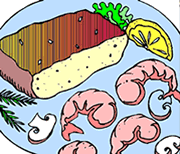 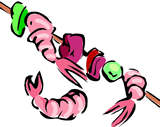
 |
Cute
little 3-pronged forks are essential for the well-bred omnivore. |
 |
 |
|
|
| |
|
|
|
|
 |
 |
 |
 |
 |
|
|

